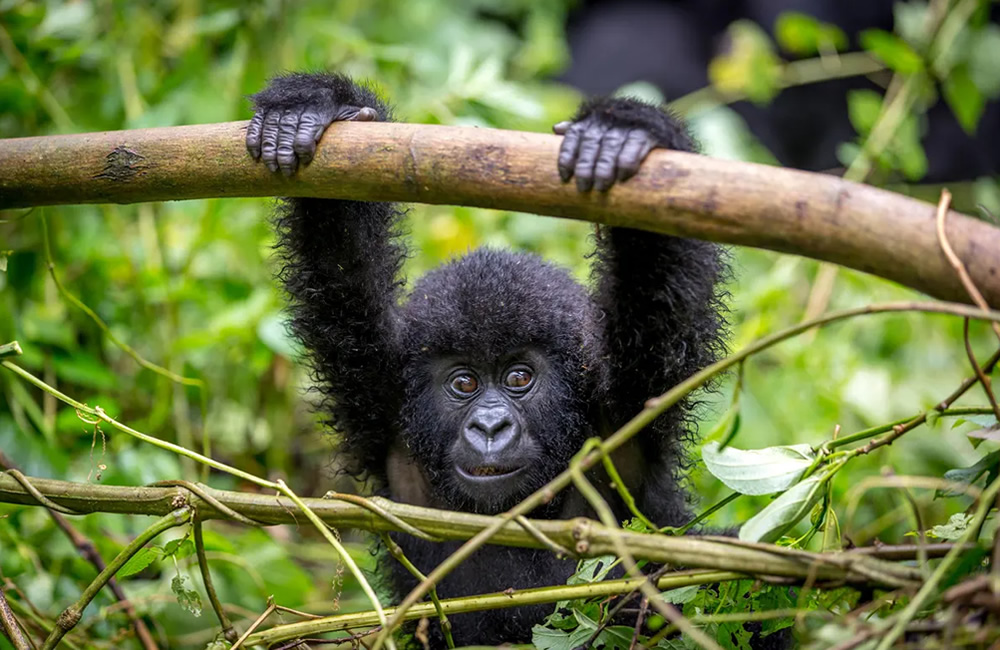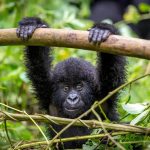During an ordinary day a mountain gorilla starts at sunrise early in the morning at 6 am and start looking for food which covers quiet a big part of their morning . They do spend 30 percent of the day travelling, 30 percent feeding and 40 percent resting and travel not more than a kilometer per day within their home range of about 20 square kilometers. They are vegetarians though occasionally they may eat insects including ants. Majorly, their meals consist of roots, leaves, stems and pith herbs, vines and fruits and their afternoons are mostly spent resting. At the end of the day before the dusk, they start constructing a nest where they spend the night and every single gorilla has to make its own nest.
Why should mountain gorillas be protected?
Following the discovery of gorillas in 1902 by a German explorer, later an American scientist George Schaller studied these mountain gorillas in the Virunga Volcanoes and Bwindi. This was followed on Dian Fossey who became famous because of her movie “Gorillas in the mist”. Before she researched, an estimated of about 450 mountain gorillas were living in the Virunga national park and only 20 years later, the population was decreased. It is very clear that the mountain gorillas is one of the most endangered species in the world and to make people protect the gorillas, it has been made possible to visit some families.
Background information about mountain gorillas
Tourists /visitors to Uganda will never find Mountain Gorillas in any zoo since they do not live in confined area. Saying the word gorilla in one’s mind will come up with many or any kind of artistic images which may range from King Kong to some Tarzan movies and it was until the 1902 when the Mountain Gorillas were identified by westerners.
By this time, Rwanda was a German colony and captain von Berenge was by then hiking Mountain Sabinyo on the Rwanda’s side along side with some friends of his. At the level of 9300 feet a group of Mountain Gorillas was fast spotted and by that time it was a young male Mountain Gorilla which was 5 years and weighing 220 pounds which was identified. It was too large enough than any other apes these adventures had seen before.
The description of Mountain Gorillas
The hair of the Mountain Gorillas is often thick and long compared to that of other Gorilla, species. This enables them to live in colder temperatures. The nose prints of the mountain gorillas are unique and the males usually weigh twice as much as females. When you are will an adult male, they do have a more pronounced bony crests on the top and back of their skulls which gives their head a conical shape.
The crests anchor a powerful master muscles and these attach to the lower jaw and the females also have crests though less pronounced. Similar to other gorilla types, mountain gorillas do feature dark brown eyes framed by a black ring. The adult male gorillas are called silver backs since a saddle of gray or silver-colored hair develops on their backs with age. On their backs, the hair is shorter compared to other body parts while on their arm, the hair is long.
A fully erect male can reach 1.9 meters in height and the arm span is of 2.3 meters, weighing 220 kilograms. The ever tallest silver back recorded was of 1.9 meters and was shot in Alimbongo, Northern Kivu. They are primarily terrestrial and quadruped; do climb into the fruiting trees as long as the branches can carry its weight. They are capable of running bipedally up to 6 meters while the young mountain gorillas play in trees like the children of human beings. In line with all other great apes than the human beings, the arms are usually longer than the legs and the do move by knuckle-walking just as the Chimpanzees, supporting its weight on the backs.


